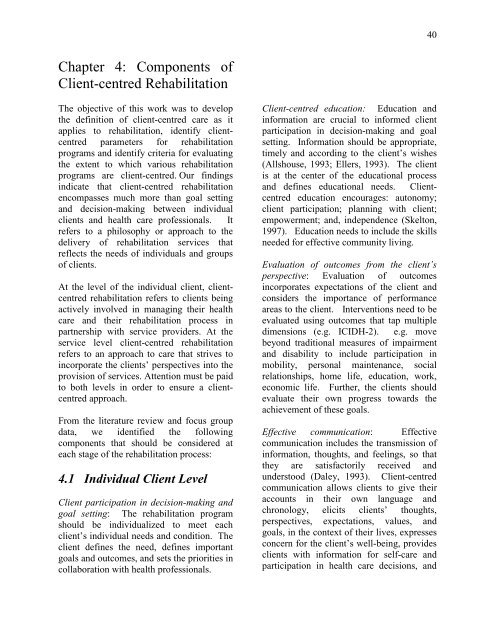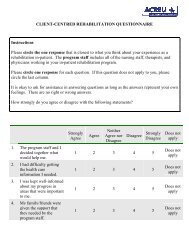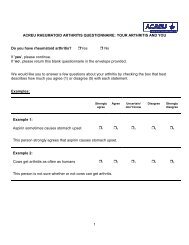Client-Centred Rehabilitation - Arthritis Community Research ...
Client-Centred Rehabilitation - Arthritis Community Research ...
Client-Centred Rehabilitation - Arthritis Community Research ...
Create successful ePaper yourself
Turn your PDF publications into a flip-book with our unique Google optimized e-Paper software.
40<br />
Chapter 4: Components of<br />
<strong>Client</strong>-centred <strong>Rehabilitation</strong><br />
The objective of this work was to develop<br />
the definition of client-centred care as it<br />
applies to rehabilitation, identify clientcentred<br />
parameters for rehabilitation<br />
programs and identify criteria for evaluating<br />
the extent to which various rehabilitation<br />
programs are client-centred. Our findings<br />
indicate that client-centred rehabilitation<br />
encompasses much more than goal setting<br />
and decision-making between individual<br />
clients and health care professionals. It<br />
refers to a philosophy or approach to the<br />
delivery of rehabilitation services that<br />
reflects the needs of individuals and groups<br />
of clients.<br />
At the level of the individual client, clientcentred<br />
rehabilitation refers to clients being<br />
actively involved in managing their health<br />
care and their rehabilitation process in<br />
partnership with service providers. At the<br />
service level client-centred rehabilitation<br />
refers to an approach to care that strives to<br />
incorporate the clients’ perspectives into the<br />
provision of services. Attention must be paid<br />
to both levels in order to ensure a clientcentred<br />
approach.<br />
From the literature review and focus group<br />
data, we identified the following<br />
components that should be considered at<br />
each stage of the rehabilitation process:<br />
4.1 Individual <strong>Client</strong> Level<br />
<strong>Client</strong> participation in decision-making and<br />
goal setting: The rehabilitation program<br />
should be individualized to meet each<br />
client’s individual needs and condition. The<br />
client defines the need, defines important<br />
goals and outcomes, and sets the priorities in<br />
collaboration with health professionals.<br />
<strong>Client</strong>-centred education: Education and<br />
information are crucial to informed client<br />
participation in decision-making and goal<br />
setting. Information should be appropriate,<br />
timely and according to the client’s wishes<br />
(Allshouse, 1993; Ellers, 1993). The client<br />
is at the center of the educational process<br />
and defines educational needs. <strong>Client</strong>centred<br />
education encourages: autonomy;<br />
client participation; planning with client;<br />
empowerment; and, independence (Skelton,<br />
1997). Education needs to include the skills<br />
needed for effective community living.<br />
Evaluation of outcomes from the client’s<br />
perspective: Evaluation of outcomes<br />
incorporates expectations of the client and<br />
considers the importance of performance<br />
areas to the client. Interventions need to be<br />
evaluated using outcomes that tap multiple<br />
dimensions (e.g. ICIDH-2). e.g. move<br />
beyond traditional measures of impairment<br />
and disability to include participation in<br />
mobility, personal maintenance, social<br />
relationships, home life, education, work,<br />
economic life. Further, the clients should<br />
evaluate their own progress towards the<br />
achievement of these goals.<br />
Effective communication: Effective<br />
communication includes the transmission of<br />
information, thoughts, and feelings, so that<br />
they are satisfactorily received and<br />
understood (Daley, 1993). <strong>Client</strong>-centred<br />
communication allows clients to give their<br />
accounts in their own language and<br />
chronology, elicits clients’ thoughts,<br />
perspectives, expectations, values, and<br />
goals, in the context of their lives, expresses<br />
concern for the client’s well-being, provides<br />
clients with information for self-care and<br />
participation in health care decisions, and








